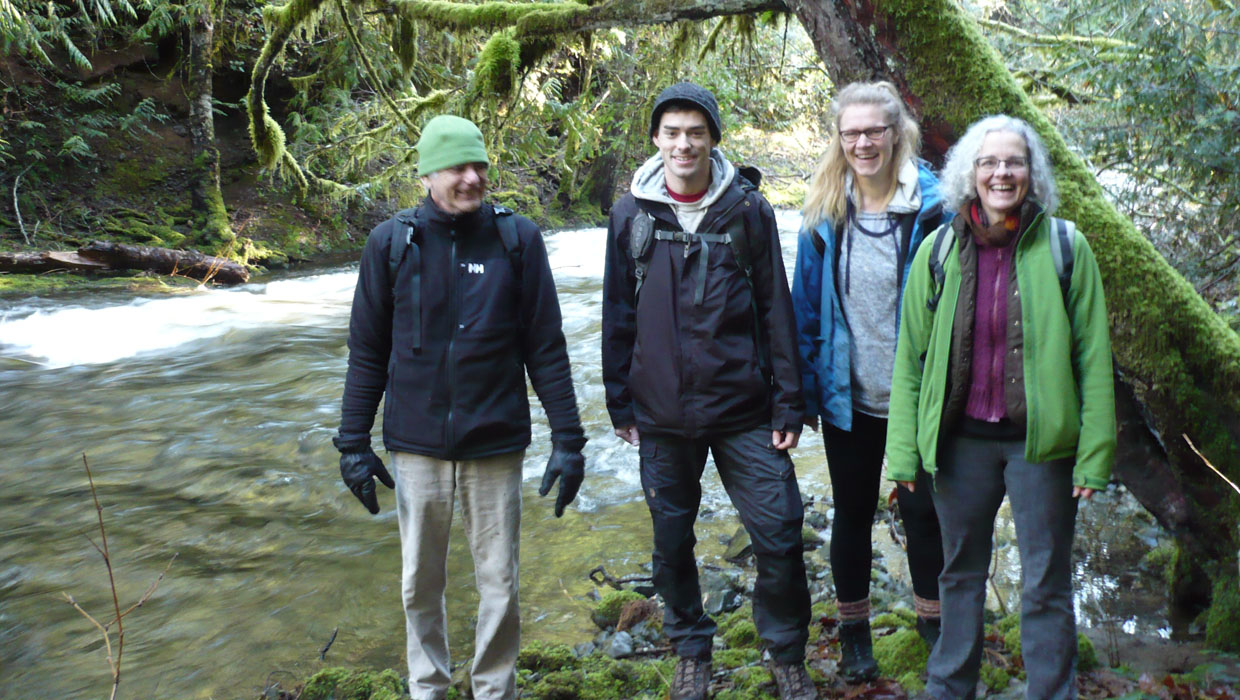On March 4, four volunteers joined TLC staff on a trip to the De Mamiel Creek covenants in Sooke. This winter monitoring excursion aimed to determine just how much water flows through De Mamiel Creek in the winter, as opposed to its almost dry state in the summer when regular covenant monitoring usually occurs.
The winter rains did not disappoint; the group were hardly able to navigate around the covenanted area due to how much water was flowing in the creek! During the summer, the water flow is so poor the creek is often only a few feet across, with stones clearly visible above the water line. However, this trip showed that De Mamiel Creek is a force to be reckoned with in the winter, as the creek was about 15-20 feet across and at least two feet deep at parts! Very fast, very cold water flowed forcefully and the volunteers made sure not to get too close, lest they fall in.
After hiking around as much as they could, the group returned the way they came and entered the covenant area again from the other side of the creek, this time accompanied by a very friendly landowner who was keen to learn about the local ecology. A geologist by trade, Bob explained the reason behind a number of trees falling across the creek from the cliff: slumping and slope destabilization due to natural erosion had weakened the cliff and, with fewer tree roots to hold the soil in place, we can expect more of this to continue. However, this is not so bad! Additional large woody debris (LWD) in the creek actually contributes to its health by creating a more structurally diverse habitat. Trees that fall in the creek, partially or wholly, will change the way the water flows and create pools and riffles which fish require during their juvenile stages. Thankfully, the cliff itself is far from landowner’s homes so there is little risk to human safety.
The covenanted areas were very well respected with no garbage or issues observed. The crew did observe evidence of old logging, shown by the cut-out section of a very large, old Douglas-fir stump. Loggers would cut into the tree to establish foot holds, placing planks of wood to stand on while cutting across the tree trunk. Volunteer Dale is pictured below, showing you just how large this veteran tree once was.
Staff member Torrey was delighted to find a certain species of fungi that had been on her “must see” list for some time – bird’s nest fungi (Nidulariaceae)!! These very small, cup-like fruiting bodies closely resemble a birds nest, complete with minuscule eggs. However, the entire fungus is only about 1 cm across which makes it very hard to spot! But spot they did and it made Torrey’s day.
You never know what treats are in store during covenant monitoring. If you would like to be a part of our summer volunteer covenant monitoring and restoration program, TLC will be holding a volunteer training session on May 5th from 10 a.m. to 12 p.m. at our office, located at 302 Denison Road at the Gonzales Observatory. Please contact Torrey at covenants@conservancy.bc.ca or 250-479-8053 to find out more or to RSVP.













